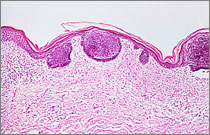Haberland J, Bertz J, Wolf U, Ziese T, Kurth BM (2010): German cancer statistics 2004
BMC Cancer 10 (1): 52-75, doi:10.1186/1471-2407-10-52.
Background
Robert Koch Institute (RKI) has been annually pooling and reviewing the data from the German population-based cancer registries and evaluating them together with the cause-of-death statistics provided by the statistical offices. Traditionally, the RKI periodically estimates the number of new cancer cases in Germany on the basis of the available data from the regional cancer registries in which registration is complete; this figure, in turn, forms the basis for further important indicators.
Methods
This article gives a brief overview of current indicators such as incidence, prevalence, mortality, survival rates on the most common types of cancer, as well as important ratios on the risks of developing and dying of cancer in Germany.
Results
According to the latest estimate, there were a total of 436,500 new cancer cases in Germany in 2004. The most common cancer in men is prostate cancer with over 58,000 new cases per annum, followed by colorectal and lung cancer. In women, breast cancer remains the most common cancer with an estimated 57,000 new cases every year, also followed by colorectal cancer. These and further findings on selected cancer sites can be found in the current brochure on "Cancer in Germany", which is regularly published by the RKI together with the Association of Population-based Cancer Registries in Germany (GEKID). In addition, the RKI made cancer-prevalence estimates and calculated current morbidity and mortality risks at the federal level for the first time. According to these figures, the 5-year partial prevalence i.e. the total number of cancer patients diagnosed over the past five years who are currently still living exceeds 600,000 in men; the figure is about the same among women. Here, too, the most common cancers are prostate cancer in men and breast cancer in women. The lifetime risk of developing cancer, which is more related to the individual, is estimated to be higher among men (48.5%) than among women (40.3%). In roughly rounded figures, therefore, about every second person in Germany develops cancer in the course of their lives. One in four men and one in five women die of cancer.
Conclusions
In recent years, population-based cancer registration in Germany has come significantly closer to the aim of the complete, nationwide coverage of cancer. The continuous improvements in the data situation help describe cancer development in Germany.






